
World Cruise: Buyer's Choice Grand World Segment Cruise
Holland America Line
Embark on an incredible journey through Asia, visiting Vietnam, Japan and Taiwan. A Hong Kong over-night offers many possibilities, from cooking classes to sightseeing tours.

Receive exclusive Costco member savings
Shipboard Credit (per person, up to two guests)♦♦
Wi-Fi Surf Package
Executive Member Benefit
Executive Members receive an annual 2% Reward, up to $1,250, on qualified Costco Travel purchases
Digital Costco Shop Card
Member Exclusive: Digital Costco Shop Card with every Holland America Line® sailing†
Sailing Itinerary

Note: Cruise itineraries are subject to change. Please verify ports and times directly with the cruise line.
Overview
Though physically small, Singapore is an economic giant. It has been Southeast Asia's most modern city for over a century. The city blends Malay, Chinese, Arab, Indian, and English cultures and religions. Its unique ethnic tapestry affords visitors a wide array of sightseeing and culinary opportunities from which to choose. A full calendar of traditional festivals and holidays celebrated throughout the year adds to its cultural appeal. In addition, Singapore offers luxury hotels, delectable cuisine,e, and great shopping! Located at the tip of the Malay Peninsula, Singapore's tropical climate welcomes both leisure and business travelers year-round. The island republic's excellent infrastructure enables visitors to enjoy its many sites and attractions in a safe, clean, and green environment. Award-winning Changi Airport provides air links to major cities around the world. The train and subway systems are clean, fast,t and efficient. In addition, its state-of-the-art cruise terminal has established Singapore as one of the premier cruising centers in Southeast Asia and an exciting port of call on any Asian cruise itinerary. In the city, there is no need for a car. Public transportation is excellent and walking is a good way to explore the city. All major attractions are also accessible by tour bus. Since the city is only 60 miles (100k) from the equator, the tropical temperatures do not vary much. Rainfall is fairly evenly distributed throughout the year. No matter when you choose to visit, warm weather will be abundantly available. The visitor is struck immediately by Singapore's abundance of parks, nature reserves, and lush, tropical greenery. Singapore's progress over the past three decades has been remarkable, yet the island has not been overwhelmed by development. Visitors will discover a wealth of historical treasures from the past, in the beauty of older buildings, values, and traditions that have survived in the face of profound social and geographical change. Lacking any noteworthy natural resources, Singapore's early prosperity was based on a vigorous free trade policy, put in place in 1819 when Sir Stamford Raffles first established it as a British trading post. Later, mass industrialization bolstered the economy, and today the state boasts the world's second busiest port after Rotterdam, minimal unemployment, and a super-efficient infrastructure. Almost the entire population lives in upscale new apartments, and the average per capita income is over US$12,000. Singapore is a clean, safe place to visit, its amenities are second to none and its public places are smoke-free and hygienic. Forming the core of downtown Singapore is the Colonial District. Each surrounding enclave has its distinct flavor, from the aromatic spice stores of Little India to the tumbledown backstreets of Chinatown, where it is still possible to find calligraphers and fortune tellers, or the Arab Quarter, whose cluttered stores sell fine cloths and silks. North of the city, are two nature preserves, Bukit Timah and the Central Catchment Area, along with the splendid Singapore Zoological Gardens. The East Coast features good seafood restaurants set on long stretches of sandy beach. In addition, there are over fifty islands and islets within Singaporean waters, all of which can be reached with varying degrees of ease. Day trips are popular to Sentosa, the island amusement arcade which is linked to the south coast by a short causeway and cable car. Music, theater, and nightlife: all are abundant in this remarkable city. Singapore used to be considered a "stopover" on the way to larger Asian cities. This is no longer true! Visitors seek out Singapore for business and finance and also for a fascinating and satisfying vacation for the whole family. Strategically located at the southern tip of the Malay Peninsula sixty miles from the equator, Singapore has for centuries been a crossroads between East and West. Chinese traders en route to India had navigated its waters from at least the 5th century. In the 14th century, it was part of the powerful Vijayan Empire and was known as Temasek or Sea Town. Legend has it that it was renamed Singa Pura or Lion City after a visiting Sumatran prince saw an animal he mistook for a lion, an animal considered a good omen. Modern Singapore came into being in 1819 when Sir Stamford Raffles claimed what was then a small fishing village as a regional base for the East India Company. The island's natural harbor and location made it an ideal site for a trading post serving British trade interests between China, the Malay world, and India. Singapore flourished as its free trade policy attracted merchants and residents from all over the world. Raffles initiated a town plan which included leveling one hill to form a new commercial district (now Raffles Place) and constructing government buildings around another hill (now called Fort Canning Hill). The British plan also involved separating the population according to ethnic categories with Europeans, Indians, Chinese,e, and Malays each living and working in the distinct quarters of the city. Revenues soared in the ensuing years from the production of opium and rubber. Millionaires were made overnight. Immigration rose steadily. The island became Britain's strategic defense base in the Far East but fell to the Japanese in 1942. After the world war ended in 1945, Singapore became a crown colony. It gained self-governing status in 1959 and independence in 1965 when it became part of the new state of Malaysia which united Malaya with Singapore, Sabah, and Sarawak. The alliance did not last. Singapore was used to being on its own, and within two years the island set up its stable government and became known as the Republic of Singapore. Under Prime Minister Lee Kuan Yew's leadership, Singapore continued to strengthen its infrastructure and its industrial base. Housing and urban renovation kept pace with population growth. The areas of health and education are strong. Singapore's leaders have also brought order and progress through strict regulation of social behavior. Smoking in public was banned, as was gum chewing. High economic growth rates have supported political stability. Singapore is the world's second busiest seaport and has an airport served by over 50 major airlines. It has state-of-the-art communication and mass transit systems. It is Asia's premier center for finance and business and the world's third-largest oil refining center. Over 7 million visit the tiny island every year.
Overview
Though physically small, Singapore is an economic giant. It has been Southeast Asia's most modern city for over a century. The city blends Malay, Chinese, Arab, Indian, and English cultures and religions. Its unique ethnic tapestry affords visitors a wide array of sightseeing and culinary opportunities from which to choose. A full calendar of traditional festivals and holidays celebrated throughout the year adds to its cultural appeal. In addition, Singapore offers luxury hotels, delectable cuisine,e, and great shopping! Located at the tip of the Malay Peninsula, Singapore's tropical climate welcomes both leisure and business travelers year-round. The island republic's excellent infrastructure enables visitors to enjoy its many sites and attractions in a safe, clean, and green environment. Award-winning Changi Airport provides air links to major cities around the world. The train and subway systems are clean, fast,t and efficient. In addition, its state-of-the-art cruise terminal has established Singapore as one of the premier cruising centers in Southeast Asia and an exciting port of call on any Asian cruise itinerary. In the city, there is no need for a car. Public transportation is excellent and walking is a good way to explore the city. All major attractions are also accessible by tour bus. Since the city is only 60 miles (100k) from the equator, the tropical temperatures do not vary much. Rainfall is fairly evenly distributed throughout the year. No matter when you choose to visit, warm weather will be abundantly available. The visitor is struck immediately by Singapore's abundance of parks, nature reserves, and lush, tropical greenery. Singapore's progress over the past three decades has been remarkable, yet the island has not been overwhelmed by development. Visitors will discover a wealth of historical treasures from the past, in the beauty of older buildings, values, and traditions that have survived in the face of profound social and geographical change. Lacking any noteworthy natural resources, Singapore's early prosperity was based on a vigorous free trade policy, put in place in 1819 when Sir Stamford Raffles first established it as a British trading post. Later, mass industrialization bolstered the economy, and today the state boasts the world's second busiest port after Rotterdam, minimal unemployment, and a super-efficient infrastructure. Almost the entire population lives in upscale new apartments, and the average per capita income is over US$12,000. Singapore is a clean, safe place to visit, its amenities are second to none and its public places are smoke-free and hygienic. Forming the core of downtown Singapore is the Colonial District. Each surrounding enclave has its distinct flavor, from the aromatic spice stores of Little India to the tumbledown backstreets of Chinatown, where it is still possible to find calligraphers and fortune tellers, or the Arab Quarter, whose cluttered stores sell fine cloths and silks. North of the city, are two nature preserves, Bukit Timah and the Central Catchment Area, along with the splendid Singapore Zoological Gardens. The East Coast features good seafood restaurants set on long stretches of sandy beach. In addition, there are over fifty islands and islets within Singaporean waters, all of which can be reached with varying degrees of ease. Day trips are popular to Sentosa, the island amusement arcade which is linked to the south coast by a short causeway and cable car. Music, theater, and nightlife: all are abundant in this remarkable city. Singapore used to be considered a "stopover" on the way to larger Asian cities. This is no longer true! Visitors seek out Singapore for business and finance and also for a fascinating and satisfying vacation for the whole family. Strategically located at the southern tip of the Malay Peninsula sixty miles from the equator, Singapore has for centuries been a crossroads between East and West. Chinese traders en route to India had navigated its waters from at least the 5th century. In the 14th century, it was part of the powerful Vijayan Empire and was known as Temasek or Sea Town. Legend has it that it was renamed Singa Pura or Lion City after a visiting Sumatran prince saw an animal he mistook for a lion, an animal considered a good omen. Modern Singapore came into being in 1819 when Sir Stamford Raffles claimed what was then a small fishing village as a regional base for the East India Company. The island's natural harbor and location made it an ideal site for a trading post serving British trade interests between China, the Malay world, and India. Singapore flourished as its free trade policy attracted merchants and residents from all over the world. Raffles initiated a town plan which included leveling one hill to form a new commercial district (now Raffles Place) and constructing government buildings around another hill (now called Fort Canning Hill). The British plan also involved separating the population according to ethnic categories with Europeans, Indians, Chinese,e, and Malays each living and working in the distinct quarters of the city. Revenues soared in the ensuing years from the production of opium and rubber. Millionaires were made overnight. Immigration rose steadily. The island became Britain's strategic defense base in the Far East but fell to the Japanese in 1942. After the world war ended in 1945, Singapore became a crown colony. It gained self-governing status in 1959 and independence in 1965 when it became part of the new state of Malaysia which united Malaya with Singapore, Sabah, and Sarawak. The alliance did not last. Singapore was used to being on its own, and within two years the island set up its stable government and became known as the Republic of Singapore. Under Prime Minister Lee Kuan Yew's leadership, Singapore continued to strengthen its infrastructure and its industrial base. Housing and urban renovation kept pace with population growth. The areas of health and education are strong. Singapore's leaders have also brought order and progress through strict regulation of social behavior. Smoking in public was banned, as was gum chewing. High economic growth rates have supported political stability. Singapore is the world's second busiest seaport and has an airport served by over 50 major airlines. It has state-of-the-art communication and mass transit systems. It is Asia's premier center for finance and business and the world's third-largest oil refining center. Over 7 million visit the tiny island every year.
Overview
Phu My is a town in Tan Thanh District, Ba Ria–Vung Tau Province. This town is home to heavy industrial parks. Industries here include: electricity, fertilizer, steel production, and deepwaterports activities.
Overview
Da Nang is a major port city in the South Central Coast of Vietnam, on the coast of the South China Sea at the mouth of the Han River. It is the commercial and educational center of Central Vietnam; its well-sheltered, easily accessible port and its location on the path of the North-South Railway also make it a hub for transportation. It is located within 100 km of several UNESCO World Heritage Sites. The city was also known as Tourane or Turon during the French colonization of Vietnam.
Overview
Halong Bay, in northeast Vietnam, is known for its emerald waters and thousands of towering limestone islands topped by rainforests. Junk boat tours and sea kayak expeditions take visitors past islands named for their shapes, including Stone Dog and Teapot islets. The region is popular for scuba diving, rock climbing, and hiking, particularly in mountainous Cat Ba National Park.
Overview
Hong Kong is a place of contrasts. Sleek, glassy skyscrapers shine above Old World markets where chicken feet and dried squid are displayed for sale. Archaic wooden boats bob past sleek cruise liners. Subway stations and expressway interchanges dot a landscape cluttered with Rolls Royce and rickshaws. Hong Kong Island was ceded to Britain in 1842 when those serving the British crown attacked the island. Though it was deeded back to China in 1997, Hong Kong enjoys a high degree of autonomy, especially in its economy and municipal government. Hong Kong is one of the most unique Chinese cities in the world. The 417-square-mile island off the coast of China offers visitors a slice of authentic Chinese culture with all the amenities of home. A modern metropolis teeming with Eastern and Western influences, Hong Kong is the world's third-largest financial center, the so-called “Wall Street of Asia,” and a shopping gold mine. Shopping? Yes indeed. Hong Kong is a duty-free port and the world's leading exporter of toys, garments, watches, and electronics. As a result, the vast majority of the 10 million annual visitors come with an empty suitcase that they fill up after visiting the malls, street bazaars (Stanley Market is world famous), textile and tailor shops, and jade and electronic stores. Those willing to look beyond the bargain-basement prices will find that Hong Kong is more than the world’s largest department store – it’s a cultural Mecca with wining and dining, museums, and historic attractions. Be sure to ride the world-famous Star Ferry across the harbor to Hong Kong Island, admire the mansions on Repulse Bay, drop in to see the temples on Cat Street, visit the fishing boats and villages in Aberdeen, and take a tram ride up to Victoria Peak (the island’s highest peak sitting 1,308-feet above the city) for a stunning panoramic view. If you have time to go further, travel to Macau, a former Portuguese colony with a casino, and the New Territories of China, a Hong Kong bedroom community that “sleeps” near China’s border.
Overview
Hong Kong is a place of contrasts. Sleek, glassy skyscrapers shine above Old World markets where chicken feet and dried squid are displayed for sale. Archaic wooden boats bob past sleek cruise liners. Subway stations and expressway interchanges dot a landscape cluttered with Rolls Royce and rickshaws. Hong Kong Island was ceded to Britain in 1842 when those serving the British crown attacked the island. Though it was deeded back to China in 1997, Hong Kong enjoys a high degree of autonomy, especially in its economy and municipal government. Hong Kong is one of the most unique Chinese cities in the world. The 417-square-mile island off the coast of China offers visitors a slice of authentic Chinese culture with all the amenities of home. A modern metropolis teeming with Eastern and Western influences, Hong Kong is the world's third-largest financial center, the so-called “Wall Street of Asia,” and a shopping gold mine. Shopping? Yes indeed. Hong Kong is a duty-free port and the world's leading exporter of toys, garments, watches, and electronics. As a result, the vast majority of the 10 million annual visitors come with an empty suitcase that they fill up after visiting the malls, street bazaars (Stanley Market is world famous), textile and tailor shops, and jade and electronic stores. Those willing to look beyond the bargain-basement prices will find that Hong Kong is more than the world’s largest department store – it’s a cultural Mecca with wining and dining, museums, and historic attractions. Be sure to ride the world-famous Star Ferry across the harbor to Hong Kong Island, admire the mansions on Repulse Bay, drop in to see the temples on Cat Street, visit the fishing boats and villages in Aberdeen, and take a tram ride up to Victoria Peak (the island’s highest peak sitting 1,308-feet above the city) for a stunning panoramic view. If you have time to go further, travel to Macau, a former Portuguese colony with a casino, and the New Territories of China, a Hong Kong bedroom community that “sleeps” near China’s border.
Overview
Kaohsiung is a city located in southwestern Taiwan, facing the Taiwan Strait on the west. Kaohsiung, officially named Kaohsiung City, is divided into thirty-eight districts. The city is one of five special municipalities of the Republic of China (Taiwan). On December 25, 2010, it merged with Kaohsiung County of Taiwan Province to form a larger municipality. Kaohsiung is the second largest city in Taiwan, with a population of around 2.9 million. It is a center for manufacturing, refining, shipbuilding, and other light and heavy industries. A major port, through which most of Taiwan's marine imports and exports, is located in the city but is not managed by the city government. Kaohsiung International Airport serving the city is the second largest airport in Taiwan. The Port of Kaohsiung is the largest harbor in Taiwan. Kaohsiung is the terminal of the Sun Yat-sen Freeway. The city is served by the railway stations of Western Line and Pingtung Line. Taiwan High-Speed Rail connects it with Taipei City. The Kaohsiung Mass Rapid Transit, the city's subway system, was launched in early 2008. Kaohsiung was the host city of the 2009 World Games, a multi-sport event primarily composed of sports not featured in the Olympic Games. The city is also home to the Republic of China Navy.
Overview
Keelung, officially known as Keelung City, is a major port city situated in the northeastern part of Taiwan. It borders New Taipei with which it forms the Taipei–Keelung metropolitan area, along with Taipei itself. Nicknamed the Rainy Port for its frequent rain and maritime role, the city is Taiwan's second-largest seaport. Keelung City is located in the northern part of Taiwan Island. It occupies an area of 132.76 km2 and is separated from its neighboring county by mountains in the east, west, and south. The northern part of the city faces the ocean and has been a great deep-water harbor since early times. Keelung has a humid subtropical climate with a yearly rainfall average of upwards of 3,700 millimeters. It has long been noted as one of the wettest and gloomiest cities in the world; the effect is related to the Kuroshio Current. Although it is one of the coolest cities in Taiwan, winters are still short and warm, whilst summers are long, relatively dry, and hot, temperatures can peek above 26°C during a warm winter day, while it can dip below 27 °C during a rainy summer day, much like the rest of northern Taiwan. However, its location on northern mountain slopes means that due to orographic lift, rainfall is heavier during fall and winter, the latter during which a northeasterly flow prevails. During summer, southwesterly winds dominate and thus there is a slight rain shadow effect. Fog is most serious during winter and spring when relative humidity levels are also highest.
Overview
Naha is the city and capital of Okinawa Ken (prefecture), Japan. It lies on southwestern Okinawa Island, which is one of the Ryukyu Islands. Long the chief city of the archipelago, it contains the Sogen Temple, the burial place of the rulers of the early Okinawa kingdom. The Shurei Gate is a fine example of Ryukyuan architecture. Naha was the seat of the post-World War II U.S. military and Okinawan governments and became the prefecture capital in 1972. Because of its deepwater port, Naha is the commercial center of the Ryukyu Islands chain. Traditional handicraft industries produce porcelain, lacquer ware, dyed cloth, and the potent awamori liquor. The city is also the seat of the University of the Ryukyus (1950).
Overview
Amami Oshima is one of the Satsunan Islands and is the largest island within the Amami archipelago between Kyushu and Okinawa. The island, 712.35 km² in area, has a population of approximately 73,000 people.
Overview
Nagasaki is the capital and the largest city of Nagasaki Prefecture located at the south-western coast of Kyushu. Nagasaki lies at the head of a long bay that forms the best natural harbor on the southern Japanese home island of Kyushu. The main commercial and residential area of the city lies on a small plain near the end of the bay. Two rivers divided by a mountain spur form the two main valleys in which the city lies. The heavily built-up area of the city is confined by the terrain to less than 4 square miles out of a total of about 35 square miles in the city as a whole. The city was rebuilt after the war, albeit dramatically changed, as any city would be after such colossal damage. New temples were built and new churches as well, since the Christian presence never died out and even increased dramatically after the war. Some of the rubble was left as a memorial, such as a one-legged torii gate and a stone arch near ground zero. New structures were also raised as memorials, such as the Atomic Bomb Museum. Nagasaki remains first and foremost a port city, supporting a rich shipping industry and setting a strong example of perseverance and peace.
Overview
Nagasaki is the capital and the largest city of Nagasaki Prefecture located at the south-western coast of Kyushu. Nagasaki lies at the head of a long bay that forms the best natural harbor on the southern Japanese home island of Kyushu. The main commercial and residential area of the city lies on a small plain near the end of the bay. Two rivers divided by a mountain spur form the two main valleys in which the city lies. The heavily built-up area of the city is confined by the terrain to less than 4 square miles out of a total of about 35 square miles in the city as a whole. The city was rebuilt after the war, albeit dramatically changed, as any city would be after such colossal damage. New temples were built and new churches as well, since the Christian presence never died out and even increased dramatically after the war. Some of the rubble was left as a memorial, such as a one-legged torii gate and a stone arch near ground zero. New structures were also raised as memorials, such as the Atomic Bomb Museum. Nagasaki remains first and foremost a port city, supporting a rich shipping industry and setting a strong example of perseverance and peace.
Overview
Blessed with a mild climate throughout the year, Shimizu is known for producing mandarin oranges, tea, and strawberries. On the coast, there is a pine-tree grove on a sand spit called Miho no Matsubara which is often mentioned in legends. From the small mountain called Nihondaira tourists can enjoy a superb view of Mt. Fuji and the light-filled city at night. Picking strawberries during the winter and spring months is a popular pastime.
Overview
Yokohama is often called the Garden City, though its name means "City by the Bay." Its waterfront area provides a port to the rest of the world as well as beautiful beaches. The waterfront district has unique art galleries and boutiques and is one of the largest Chinatown areas in Japan. Yokohama is the home of Japan's Central Baseball League and Japan's first coffee shop. There is even an indoor beach with sand and water and waves! The second largest city in Japan, Yokohama is home to 3 million people and is a growing, innovative business center. Its large, accessible port has made it Japan's largest international trading center. It certainly maintains its own identity and does not fall into the shadow of Tokyo, a mere 18.6 miles (30 kilometers) from Tokyo.
Onboard the Volendam
Volendam
Year Built: 1999
Year Refurbished: 2014
Double Occupancy Capacity: 1432
The beautiful garden theme of Volendam is reflected in an artful floral motif throughout the ship's spacious public rooms and elegant staterooms. Flowers are found in abundance in floral fabrics and tapestries, as well as huge vases of fresh floral arrangements. Guests aboard Volendam enjoy wide teak decks, elegant dining rooms and spacious staterooms — many with private verandahs.
Activities & Services (included in cruise)
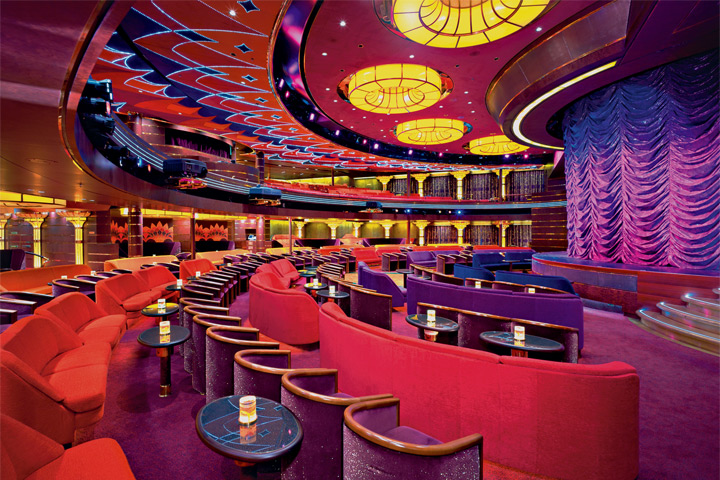
Show Lounge
- Card Room
- Casino
- Disco/Nightclub
- Movies
- Theater/Show Lounge
- Fitness Center
- Sauna/Steam Room
- Culinary Arts Center
- Educational Programs
- Pool - Outdoor
- Sports Facilities
- Whirlpool/Jacuzzi
- Art Gallery
- Bars/Lounges
- Library
- Children's Indoor Play Area
- Organized Age Specific Activities
- Teen Center or Disco
- Teen Programs
- Business Center
- Concierge Desk
- Duty-Free Shops/Boutiques
- Elevators
- Safe Deposit Boxes
Activities & Services (available for an extra fee)
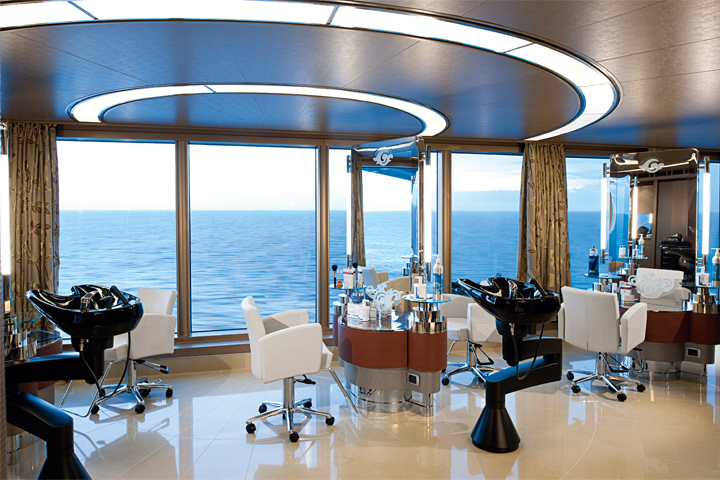
Greenhouse Salon
- Beauty Salon
- Full-Service Spa
- Internet Center
- Babysitting
- Dry Cleaning/ Laundry Service
- Infirmary/Medical Center
- Self-Service Laundromat
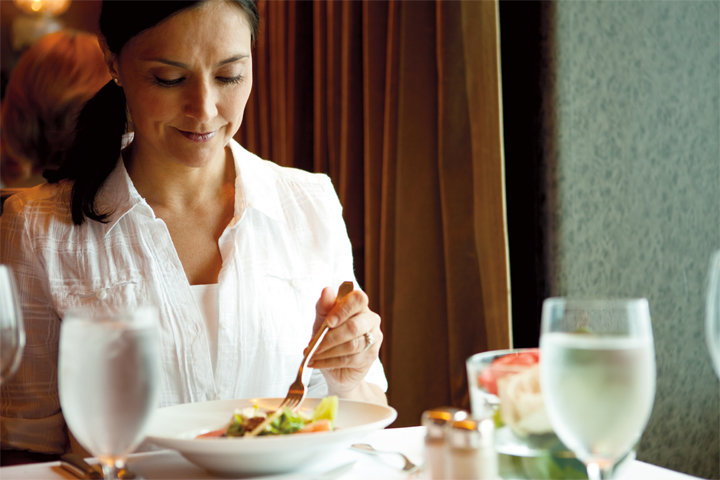
Dining Room
Main Dining
The Dining Room: For breakfast, lunch or an unforgettable five-course dinner, the elegant main dining room is your destination for sophisticated dining, with menu selections from classic favorites to vegetarian options, to dishes inspired by the regions you’ll visit. Menus by Holland America Line's Culinary Council® of world-renowned chefs.
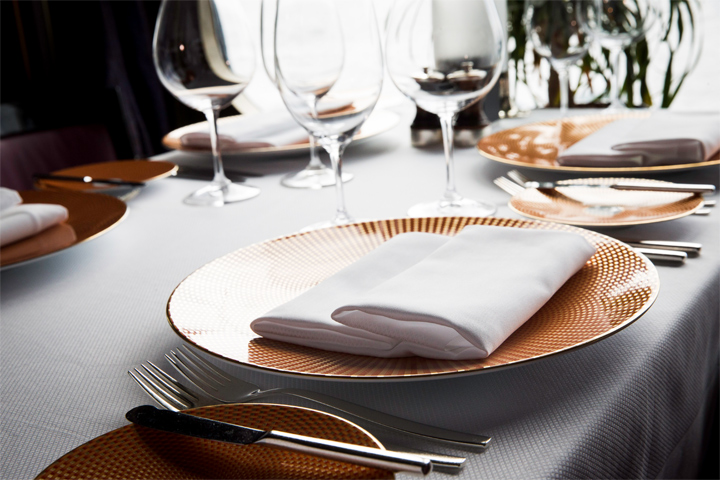
Pinnacle Grill
Specialty Dining
Pinnacle Grill: Enjoy dishes inspired by America’s Pacific Northwest, such as king salmon from Alaska and choice, responsibly raised beef from Washington State’s Double R Ranch. Complement your meal with a selection of boutique wines from the Pacific Northwest and other celebrated vineyards from around the world. This restaurant is available for an additional cost.
Canaletto: This authentic Italian restaurant offers a menu that celebrates spartire (Italian for "sharing"). Try braised chicken cacciatore "al forno," branzino ai ferri or a classic Italian pasta: spaghetti pomodoro or garlic shrimp-infused ravioli, perhaps. Buon appetito! This restaurant is available for an additional cost.
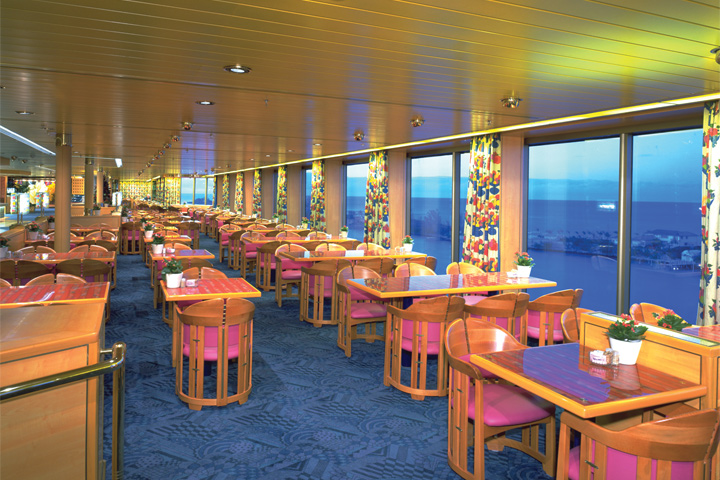
Lido Market
Casual Dining
Lido Market: Lido Market provides a fresh, new approach to casual dining for breakfast, lunch or dinner, with a panoramic view of the sea. A modern marketplace with different themed stations, the Lido offers a curated selection of delicious options to grab on the go or to have quickly made to order.
Dive-In: Dive in to a grilled burger on brioche or a Nathan’s Famous gourmet hot dog. For alfresco dining by the pool, Dive-In has it all, including lighter fare like the grilled chicken breast sandwich and vegetarian-friendly portabella mushroom stack.
Explorations Café: A comfortable, coffeehouse environment offering espresso drinks and pastries. This restaurant is available for an additional cost.
Room Service: Complimentary 24-hour dining in the comfort of your stateroom.
Staterooms feature premium massage showerheads, fine linens and fresh fruit upon request.
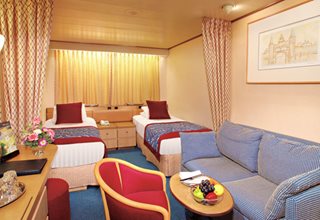
Category: N
Amenities- Daily housekeeping
- Complimentary 24-hour room service
- Elemis Aromapure soap, lotion, shampoo
- Luxurious bathrobes
- Hair dryers, makeup mirrors
- Generous storage
- Fresh fruit upon request
- Safe
- Ice service
- Shoeshine
- TV with On Demand movies, programming

Category: MM
Amenities- Daily housekeeping
- Complimentary 24-hour room service
- Elemis Aromapure soap, lotion, shampoo
- Luxurious bathrobes
- Hair dryers, makeup mirrors
- Generous storage
- Fresh fruit upon request
- Safe
- Ice service
- Shoeshine
- TV with On Demand movies, programming

Category: M
Amenities- Daily housekeeping
- Complimentary 24-hour room service
- Elemis Aromapure soap, lotion, shampoo
- Luxurious bathrobes
- Hair dryers, makeup mirrors
- Generous storage
- Fresh fruit upon request
- Safe
- Ice service
- Shoeshine
- TV with On Demand movies, programming

Category: L
Amenities- Daily housekeeping
- Complimentary 24-hour room service
- Elemis Aromapure soap, lotion, shampoo
- Luxurious bathrobes
- Hair dryers, makeup mirrors
- Generous storage
- Fresh fruit upon request
- Safe
- Ice service
- Shoeshine
- TV with On Demand movies, programming

Category: K
Amenities- Daily housekeeping
- Complimentary 24-hour room service
- Elemis Aromapure soap, lotion, shampoo
- Luxurious bathrobes
- Hair dryers, makeup mirrors
- Generous storage
- Fresh fruit upon request
- Safe
- Ice service
- Shoeshine
- TV with On Demand movies, programming

Category: J
Amenities- Daily housekeeping
- Complimentary 24-hour room service
- Elemis Aromapure soap, lotion, shampoo
- Luxurious bathrobes
- Hair dryers, makeup mirrors
- Generous storage
- Fresh fruit upon request
- Safe
- Ice service
- Shoeshine
- TV with On Demand movies, programming

Category: I
Amenities- Daily housekeeping
- Complimentary 24-hour room service
- Elemis Aromapure soap, lotion, shampoo
- Luxurious bathrobes
- Hair dryers, makeup mirrors
- Generous storage
- Fresh fruit upon request
- Safe
- Ice service
- Shoeshine
- TV with On Demand movies, programming
Elegant staterooms feature luxurious bedding, premium massage showerheads, a porthole or a window and fresh fruit upon request.
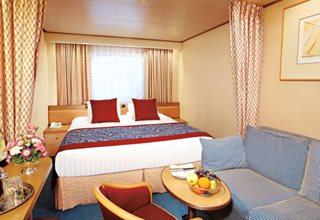
Category: HH
Amenities- Daily housekeeping
- Complimentary 24-hour room service
- Elemis Aromapure soap, lotion, shampoo
- Luxurious bathrobes
- Hair dryers, makeup mirrors
- Generous storage
- Fresh fruit upon request
- Safe
- Ice service
- Shoeshine
- TV with On Demand movies, programming

Category: H
Amenities- Daily housekeeping
- Complimentary 24-hour room service
- Elemis Aromapure soap, lotion, shampoo
- Luxurious bathrobes
- Hair dryers, makeup mirrors
- Generous storage
- Fresh fruit upon request
- Safe
- Ice service
- Shoeshine
- TV with On Demand movies, programming

Category: G
Amenities- Daily housekeeping
- Complimentary 24-hour room service
- Elemis Aromapure soap, lotion, shampoo
- Luxurious bathrobes
- Hair dryers, makeup mirrors
- Generous storage
- Fresh fruit upon request
- Safe
- Ice service
- Shoeshine
- TV with On Demand movies, programming

Category: FF
Amenities- Daily housekeeping
- Complimentary 24-hour room service
- Elemis Aromapure soap, lotion, shampoo
- Luxurious bathrobes
- Hair dryers, makeup mirrors
- Generous storage
- Fresh fruit upon request
- Safe
- Ice service
- Shoeshine
- TV with On Demand movies, programming

Category: F
Amenities- Daily housekeeping
- Complimentary 24-hour room service
- Elemis Aromapure soap, lotion, shampoo
- Luxurious bathrobes
- Hair dryers, makeup mirrors
- Generous storage
- Fresh fruit upon request
- Safe
- Ice service
- Shoeshine
- TV with On Demand movies, programming

Category: EE
Amenities- Daily housekeeping
- Complimentary 24-hour room service
- Elemis Aromapure soap, lotion, shampoo
- Luxurious bathrobes
- Hair dryers, makeup mirrors
- Generous storage
- Fresh fruit upon request
- Safe
- Ice service
- Shoeshine
- TV with On Demand movies, programming

Category: E
Amenities- Daily housekeeping
- Complimentary 24-hour room service
- Elemis Aromapure soap, lotion, shampoo
- Luxurious bathrobes
- Hair dryers, makeup mirrors
- Generous storage
- Fresh fruit upon request
- Safe
- Ice service
- Shoeshine
- TV with On Demand movies, programming

Category: DD
Amenities- Daily housekeeping
- Complimentary 24-hour room service
- Elemis Aromapure soap, lotion, shampoo
- Luxurious bathrobes
- Hair dryers, makeup mirrors
- Generous storage
- Fresh fruit upon request
- Safe
- Ice service
- Shoeshine
- TV with On Demand movies, programming

Category: DA
Amenities- Daily housekeeping
- Complimentary 24-hour room service
- Elemis Aromapure soap, lotion, shampoo
- Luxurious bathrobes
- Hair dryers, makeup mirrors
- Generous storage
- Fresh fruit upon request
- Safe
- Ice service
- Shoeshine
- TV with On Demand movies, programming

Category: D
Amenities- Daily housekeeping
- Complimentary 24-hour room service
- Elemis Aromapure soap, lotion, shampoo
- Luxurious bathrobes
- Hair dryers, makeup mirrors
- Generous storage
- Fresh fruit upon request
- Safe
- Ice service
- Shoeshine
- TV with On Demand movies, programming

Category: C
Amenities- Daily housekeeping
- Complimentary 24-hour room service
- Elemis Aromapure soap, lotion, shampoo
- Luxurious bathrobes
- Hair dryers, makeup mirrors
- Generous storage
- Fresh fruit upon request
- Safe
- Ice service
- Shoeshine
- TV with On Demand movies, programming
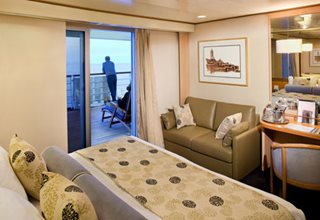
Category: CA
Amenities- Daily housekeeping
- Complimentary 24-hour room service
- Elemis Aromapure soap, lotion, shampoo
- Luxurious bathrobes
- Hair dryers, makeup mirrors
- Generous storage
- Fresh fruit upon request
- Safe
- Ice service
- Shoeshine
- TV with On Demand movies, programming
Spacious staterooms have a private balcony, whirlpool bath (some with shower only) and more.
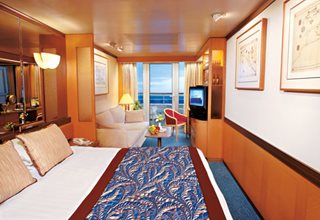
Category: BC
Amenities- Daily housekeeping
- Complimentary 24-hour room service
- Elemis Aromapure soap, lotion, shampoo
- Luxurious bathrobes
- Hair dryers, makeup mirrors
- Generous storage
- Fresh fruit upon request
- Safe
- Ice service
- Shoeshine
- TV with On Demand movies, programming
- Binoculars
- Whirlpool bath

Category: BB
Amenities- Daily housekeeping
- Complimentary 24-hour room service
- Elemis Aromapure soap, lotion, shampoo
- Luxurious bathrobes
- Hair dryers, makeup mirrors
- Generous storage
- Fresh fruit upon request
- Safe
- Ice service
- Shoeshine
- TV with On Demand movies, programming
- Binoculars
- Whirlpool bath

Category: B
Amenities- Daily housekeeping
- Complimentary 24-hour room service
- Elemis Aromapure soap, lotion, shampoo
- Luxurious bathrobes
- Hair dryers, makeup mirrors
- Generous storage
- Fresh fruit upon request
- Safe
- Ice service
- Shoeshine
- TV with On Demand movies, programming
- Binoculars
- Whirlpool bath

Category: AA
Amenities- Daily housekeeping
- Complimentary 24-hour room service
- Elemis Aromapure soap, lotion, shampoo
- Luxurious bathrobes
- Hair dryers, makeup mirrors
- Generous storage
- Fresh fruit upon request
- Safe
- Ice service
- Shoeshine
- TV with On Demand movies, programming
- Binoculars
- Whirlpool bath

Category: A
Amenities- Daily housekeeping
- Complimentary 24-hour room service
- Elemis Aromapure soap, lotion, shampoo
- Luxurious bathrobes
- Hair dryers, makeup mirrors
- Generous storage
- Fresh fruit upon request
- Safe
- Ice service
- Shoeshine
- TV with On Demand movies, programming
- Binoculars
- Whirlpool bath
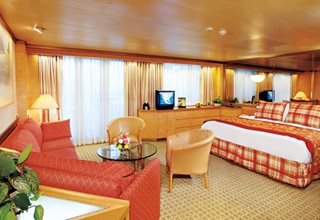
Category: SA
Amenities- Daily housekeeping
- Complimentary 24-hour room service
- Elemis Aromapure soap, lotion, shampoo
- Premium bathrobes, slippers
- Hair dryers, makeup mirrors
- Generous storage
- Fresh fruit upon request
- Safe
- Ice service
- Shoeshine
- TV with On Demand movies, programming
- Fresh flowers
- One-Touch concierge service
- Whirlpool bath
- In-suite coffee, espresso
- Complimentary laundry
- Pre-dinner hors d'oeuvres served in suite
- Welcome glass of sparkling wine
- Priority boarding for tender ports, priority dining/seating requests, special disembarkation service
- High tea in suite on request
- Binoculars
- Exclusive tote bag

Category: SB
Amenities- Daily housekeeping
- Complimentary 24-hour room service
- Elemis Aromapure soap, lotion, shampoo
- Premium bathrobes, slippers
- Hair dryers, makeup mirrors
- Generous storage
- Fresh fruit upon request
- Safe
- Ice service
- Shoeshine
- TV with On Demand movies, programming
- Fresh flowers
- One-Touch concierge service
- Whirlpool bath
- In-suite coffee, espresso
- Complimentary laundry
- Pre-dinner hors d'oeuvres served in suite
- Welcome glass of sparkling wine
- Priority boarding for tender ports, priority dining/seating requests, special disembarkation service
- High tea in suite on request
- Binoculars
- Exclusive tote bag
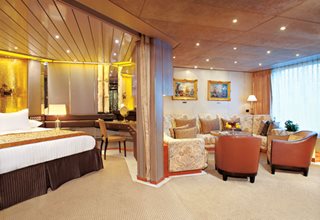
Category: PS
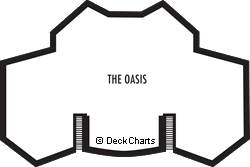
| Symbol | Description |
|---|---|
 | Shower only |
 | Bathtub & shower |
 | 2 lower beds convert to 1 queen-size bed (no sofa bed) |
 | Triple (2 lower beds, 1 sofa bed) |
 | Quad (2 lower beds, 1 sofa bed, 1 upper) |
 | Partial sea view |
 | These staterooms have portholes instead of windows |
 | 2 lower beds not convertible to a queen-size bed |
 | Fully obstructed view |
 | Suites B7088, B7087, B6228, and B6225 and stateroom EE3429 are fully accessible, roll-in shower only |
 | Suite SA7034 is fully accessible with single side approach to the bed, bathtub, and roll-in shower; Staterooms DA6104, G1805, and G1804 are fully accessible with single side approach to the bed, roll-in shower only |
 | Staterooms EE3396, EE3391, HH3431, HH3430, E2702, L2700, J2555, J2554, G2500, FF1964, FF1955, G1807, and G1806 are ambulatory accessible, roll-in shower only |
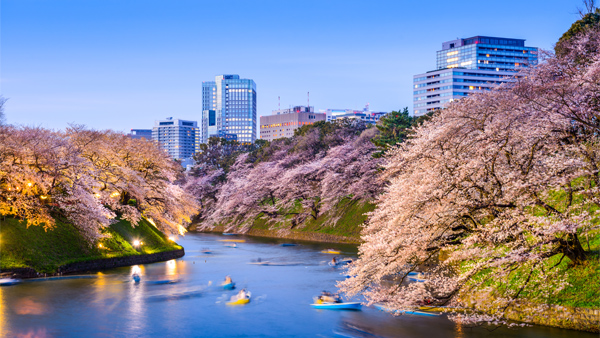
- Ship Name: Volendam
- Year Built: 1999
- Year Refurbished: 2014
- Year Entered Present Fleet: 1999
- Ship Class: R
- Maximum Capacity: 1,837
- Number of Passenger Decks: 10
- Number of Crew: 615
- Officers' Nationality: International
- Ocean-View without Balcony: 385
- Total Inside Staterooms: 134
- Tonnage (GRT): 61,214
- Capacity Based on Double Occupancy: 1,432
- Country of Registry: Netherlands
- Total Staterooms: 716
- Suites with Balcony: 197
- Crew/Hotel Staff Nationality: International
Costco Member Reviews

Available Dates & Prices
Terms & Conditions
*Price shown is per person based on double occupancy, is valid for select stateroom categories only, and does not include the Buyer's Choice Included Extras. The Buyer's Choice rate will be shown in the Rates section on the Stateroom Category page during booking.
♦Included Extras are for first and second passengers only unless noted otherwise. Shipboard credit has no cash value, is nontransferable, and is not redeemable for cash.
♦♦Onboard credit amounts are based on the stateroom booked and apply to Oceanview staterooms and above.
†One Digital Costco Shop Card per room/stateroom, per stay. The exact amount of the Digital Costco Shop Card will be calculated during the booking process. The Digital Costco Shop Card promotion is nontransferable and may not be combined with any other promotion. A Digital Costco Shop Card will arrive by email approximately 10 days after the start of your cruise. Click on the Terms & Conditions link below for additional information.
Ship's registry: The Netherlands
Digital Costco Shop Card
Book this vacation or cruise with Costco Travel and receive a Digital Costco Shop Card. The Digital Costco Shop Card is a convenient payment option in our warehouses and on Costco.ca.



















